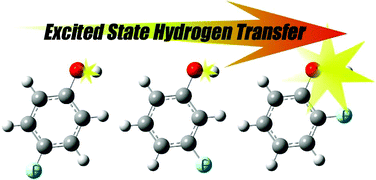Excited state hydrogen transfer in fluorophenol·ammonia clusters studied by two-color REMPI spectroscopy
Abstract
Two-color (1 + 1′)

* Corresponding authors
a Chemical Resources Laboratory, Tokyo Institute of Technology, 4259 Nagatsuta, Midori-ku, Yokohama, Japan
b Department of Chemistry, Graduate School of Science, Hiroshima University, Higashi-hiroshima, Japan
c Laboratoire de Photophysique Moléculaire Bat. 213, Universitde Paris-sud, Orsay Cedex, France
Two-color (1 + 1′)

 Please wait while we load your content...
Something went wrong. Try again?
Please wait while we load your content...
Something went wrong. Try again?
N. Tsuji, S. Ishiuchi, M. Sakai, M. Fujii, T. Ebata, C. Jouvet and C. Dedonder-Lardeux, Phys. Chem. Chem. Phys., 2006, 8, 114 DOI: 10.1039/B511619H
To request permission to reproduce material from this article, please go to the Copyright Clearance Center request page.
If you are an author contributing to an RSC publication, you do not need to request permission provided correct acknowledgement is given.
If you are the author of this article, you do not need to request permission to reproduce figures and diagrams provided correct acknowledgement is given. If you want to reproduce the whole article in a third-party publication (excluding your thesis/dissertation for which permission is not required) please go to the Copyright Clearance Center request page.
Read more about how to correctly acknowledge RSC content.
 Fetching data from CrossRef.
Fetching data from CrossRef.
This may take some time to load.
Loading related content
